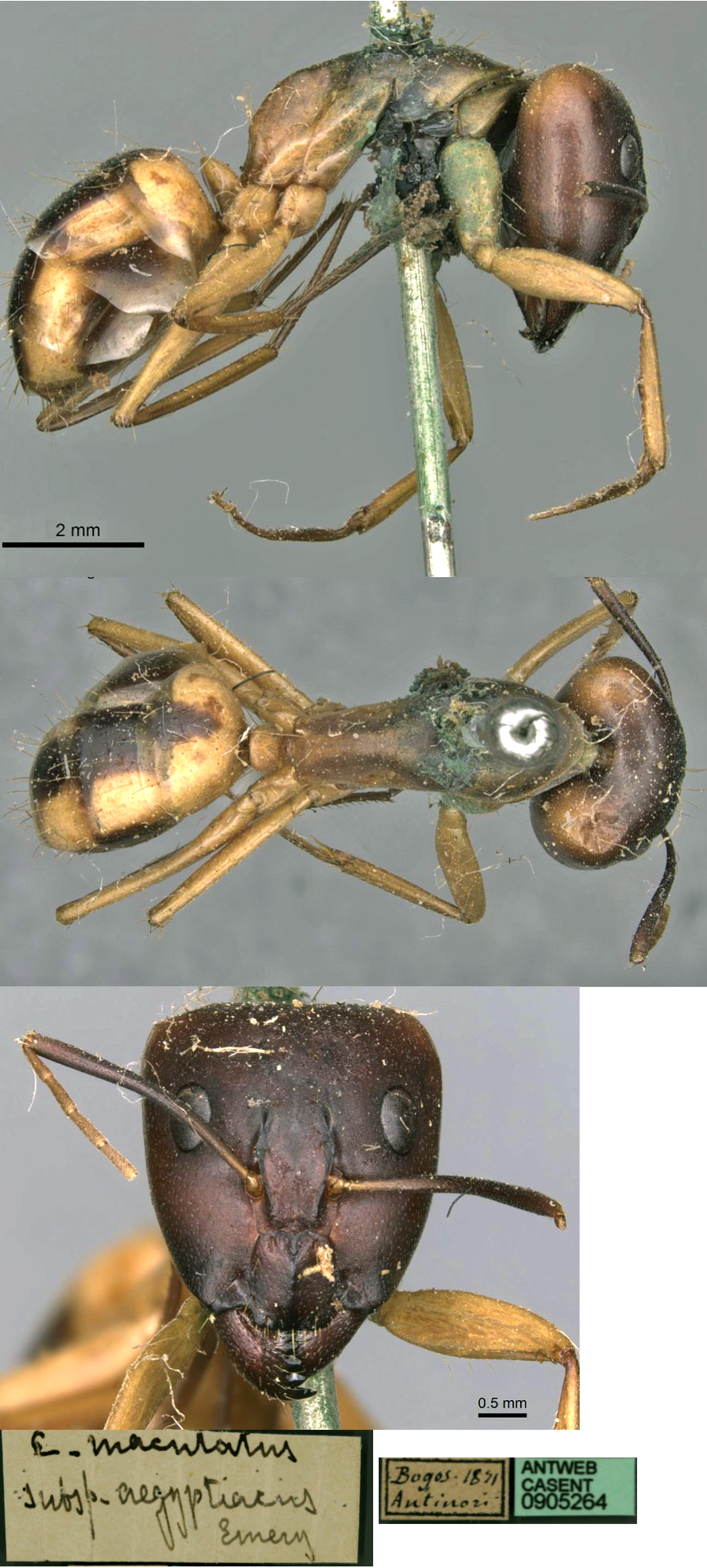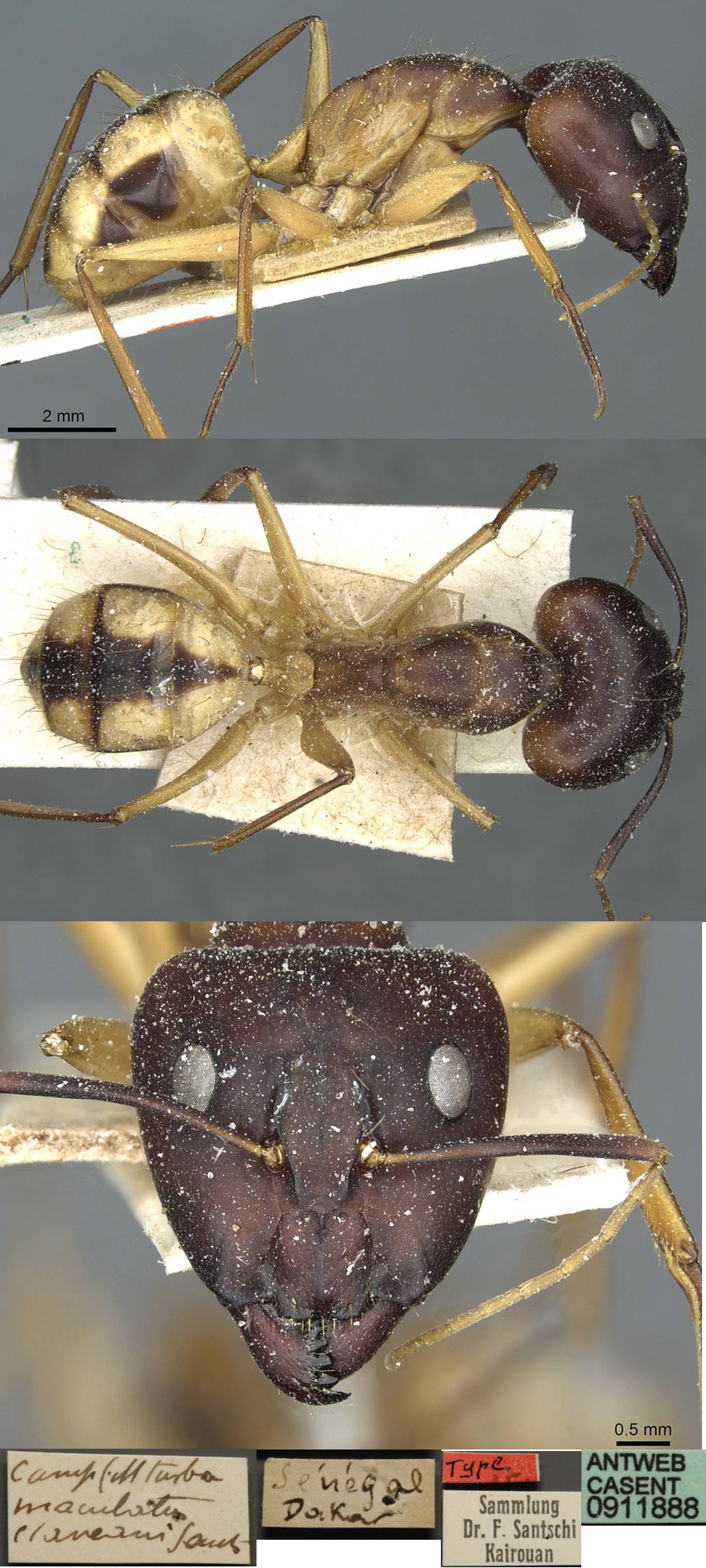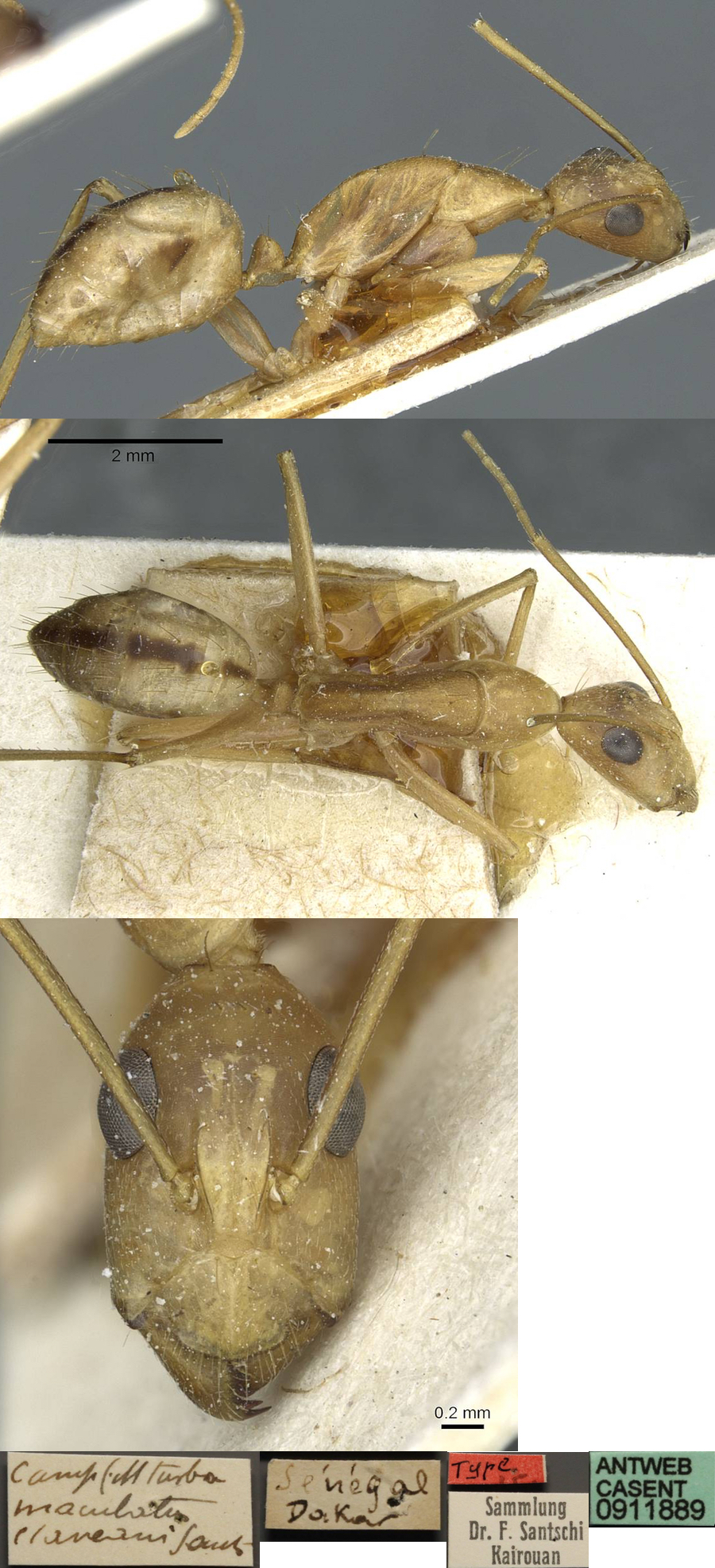Camponotus (Tanaemyrmex) aegyptiacus Emery
  Type locality Egypt (Camponotus
maculatus aegyptiacus n. subsp., Emery, 1915f: 79, worker;
Menozzi, 1932e: 453, queen & male; raised to species Baroni Urbani,
1972: 130). Note Emery (1915g: 4) listed "C. (M.) aegyptiacus
n.; Ghinda, Nefasit, worker, queen & male"; thus the type location
would be Eritrea; in the 1915f paper he gave no precise location - see
below. Type locality Egypt (Camponotus
maculatus aegyptiacus n. subsp., Emery, 1915f: 79, worker;
Menozzi, 1932e: 453, queen & male; raised to species Baroni Urbani,
1972: 130). Note Emery (1915g: 4) listed "C. (M.) aegyptiacus
n.; Ghinda, Nefasit, worker, queen & male"; thus the type location
would be Eritrea; in the 1915f paper he gave no precise location - see
below.
junior synonym infrasquameus (Camponotus (Myrmoturba)
maculatus Fab. stirps infrasquameus n. st., Santschi,
1926b: 249,
soldier, worker & queen) from Benin, Kouandé, Desanti -
see http://www.antweb.org/specimenImages.do?code=casent0911892
material of
unavailable names
claveaui (Camponotus (Myrmoturba) maculatus
F. stirps aegyptiacus Em. var. claveaui n. var.,
Santschi, 1926b: 250, worker) from Senegal, Dakar, Claveau -
see http://www.antweb.org/specimenImages.do?code=casent0911888
sudanicus (Camponotus (Myrmoturba) maculatus
F. stirps aegyptiacus Em. var.
sudanicus n. var., Santschi, 1926b: 250, soldier & worker) from
Congo, Zinder Region, 1901, Dr Gallard - http://www.antweb.org/specimenImages.do?code=casent0911890
also hyskos (Camponotus
(Myrmoturba) maculatus stirps aegyptiacus var. hyskos,
Santschi, 1938a: 41, worker) from Egypt, status questionable
according to Baroni Urbani (1972: 133) - no images on Antweb (September
2014)
all forms described (see Bolton,
1995)  . .
|
 Emery's (1915f) consideration of the maculatus-group
and definition of aegyptiacus is at Emery's (1915f) consideration of the maculatus-group
and definition of aegyptiacus is at 
Santschi's (1926b) description of sudanicus, from (French)
Congo (Tilho Mission, Region de Zinder, Danagherim Sultanate, by Dr
Gallard, 1910) is at  ; his description of claveaui
(from Dakar, Senegal, collected by Claveau) is at ; his description of claveaui
(from Dakar, Senegal, collected by Claveau) is at  ; and his description of infrasquameus
(from Benin (Dahomey), at Kouandé, by Desanti) is at ; and his description of infrasquameus
(from Benin (Dahomey), at Kouandé, by Desanti) is at  . Santschi (1938a) noted hyskos
was almost identical to the type aegyptiaca but
had much reduced dark patches on the gaster and had a dozen hairs on
the underside of the head. . Santschi (1938a) noted hyskos
was almost identical to the type aegyptiaca but
had much reduced dark patches on the gaster and had a dozen hairs on
the underside of the head.
|
Note There is no proper original description of C.
aegyptiacus. All we have is Emery's note that the distinct species
has almost entirely yellow legs, wheras the true type C. maculatus maculatus has black tibiae. The allocation by Santschi (1926b) of
the three new varieties to aegyptiacus falls down on the
following:
Larger - claveaui TL 13-14 mm, HW 3.8 mm (type
3.3 mm), hind tibia length 4.5 mm; minor head narrower and longer,
scape 2.9 mm, surpassing the occiput by about half its length, head
shape straighter behind the eyes
Smaller and clearly quite different - infrasquameus
TL 6.5-11 mm, HW narrower (than the type at 3 mm), scape longer ( minor
scape length 2.9 mm, occiput more concave, minor with narrower dark
banding on the gaster, head much narrower, petiole scale much lower.
Baroni Urbani (1972: 131) ignores the size variation
altogether, taking colouration as a simple matter of variation. This
simplistic approach clearly has to be questioned.
In the specimens shown below the major TL is about 13
mm, HW about 2.6 mm, hind tibia length about 2.9 mm. The minor
has a high narrow petiole scale and the short scape ca 2 mm, as implied
by Santschi. Collingwood also had the specimens from Saudi Arabia as
with HW 3.5 mm or less.
|
 From Egypt, it
was illustrated by Savigny (Audouin, J.-V.
1825-27: Plate 20 Fig 8). From Egypt, it
was illustrated by Savigny (Audouin, J.-V.
1825-27: Plate 20 Fig 8).
Egypt records - Alfieri (1931: 48) listed 52
collections in the 1925 survey, in Cairo and its suburbs, from the
Provinces of Charkieh, Fayoum, Assiout and Keneh; Santschi (1938a: 40)
also listed numerous findings; Donisthorpe (1942a) listed numerous
specimens from the Siwa Oasis area, all collected by J Omer-Cooper,
June-July 1935; he later reported further specimens of all forms from
Siwa, Siwa depression, Koreshid, Zeitoun and Abu Sharuf (Donisthorpe
(1947e).
Sharaf list - Ghazal Island (Aswan), 2.v.2002 (18);
Cairo, 15.vi.2003 (6); Saloga Island (Aswan), 2.v.2002 (2); Ismailia,
13.xii.1997 (1); Abuzabal (Qalyubiya),30.ix.2001 (1); Flosyiat, Zaranik
(North Sinai), 11.viii.2000 (1) (SHC); Dakhla oasis, 6.ii.1953 (7)
Leg.M.R.Sharaf; Pyramids (Giza), 20.ix.1952 (1); Pyramids (Giza),
19.i.1953 (4); Kharga Oasis, 10.ii.1953 (2); Barkash, 6.v.1952 (1);
Khatatba, 7.viii.1953 (1); Benha (Qalyubiya), 1.viii.1953 (1) (ASUC);
Marg (Cairo), 4.iv.1915 (1) (EESC); Giza, 5.i.1953 (12 ?); Giza,
6.i.1955 (4?); Giza, 29.xii.1952 (2); Giza, 29.xii.1953 (12);
Abu-Rawash, 3.iv.1955 (6); Faiyum, 9.v.1953 (13); Faiyum, 15.iv.1953
(1); Helwan, 6.iv.1934, Farag (1); Giza, 5.iii.1953 (1); Giza,
13.ii.1955 (1) (CUC). Local distribution: Cairo, Marsa Matrouh,
Pyramids, Dakhla oasis, Kharga oasis, Benha, Assiut, Luxor, Abu-Rawash,
Safaga, Siwa, Tanta, El-Mahalla, Baharyia oasis, El-Simbillawein.
Mohamad thesis (1979) had - Cairo, 2.vi.1912; 14.v.1922;
22.vii.1929; 10.viii.1937; 4.v.1941; Shubra (Cairo), 30.i; 12.v.1918;
Gezira (Cairo), 6.vi.1918; Egypt (Det.Crawley, 1927); Maadi (Cairo),
1.v.1927; Katta, 10.vii.1935 (Coll.Alf.). Zeitoun (Cairo),
11.v.1925; Egypt (Det.Crawley,1927) (Coll.Min.). Birqash,
11.v.1925; Marsa Matrouh, viii.1952; Pyramids (Giza), 20.ix.1952,
19.i.1953; El-Basateen (Cairo), 5.i.1953; Dakhla oasis (Western
desert), 6.ii.1953; Kharga oasis (Western desert), 10.ii.1953; Benha
(Qaliobyia), 1.viii.1953; El-Khatatba, 7.viii.1953; Asiut (Upper
Egypt), 4.ii.1975; Luxor (Upper Egypt), 6-7.ii.1975; Cairo, 4.iii
,1.iv., 18.iv., 22.iv., 27.v.1975; Heliopolis (Cairo), 16.iii.,
12.iv.,4.VII., 13.viii.1975; Abu-Rawash, 8.vi.1975; Kom Oshim (Fayium),
7.vii.1975; Alexandria, 5.viii.1975; Safaga (Red Sea), 20.xi.1975; Siwa
oasis (Western desert), 9, 14.iv.1976; Pyramids (Giza), 18.v.1976;
Tanta (Nile Delta), 7.xii.1977; El-Mahalla El-Kobra (Nile Delta),
8.xii.1977; Baharyia oasis (Western desert), 20.i.1978; Dakhla oasis
(Western desert), 21.i.1978; Quiesna (Nile Delta), 22.i.1978; Kharga
oasis (Western desert), 24.i.1978; El-Simbellawein (Dakahlyia),
24.i.1978; Benimazar (El-Menyia), 28.i.1978; Baharyia oasis (Western
desert), 4-6.iii.1976 (Coll.Ain.).
|
Emery (1915f) laid
stress on the type form of maculatus
(as described by Linnaeus from the Bank's Collection in London) having
ferruginous femora and black lower legs, whereas the form common in
Egypt and neighbouring countries had completely pale legs. Collingwood
(1985), recording it from
Saudi Arabia, noted that in profile the dorsal outline of the alitrunk
is more or less continuous; the gaster with a distinct pattern of 2 or
3 yellow blotches, which merge into each other laterally giving an
irregular banded effect; gula hairs present but not numerous; smaller
species, HW 3.5 mm or less. He added that it is a common north east
African species; mainly active at night when foragers can be seen
flitting very rapidly over the ground in search of food; the minor
workers are very pale.
|
 The photomontage of a
major worker
from the Emery collection is collated from http://www.antweb.org/specimen.do?name=casent0905264. The photomontage of a
major worker
from the Emery collection is collated from http://www.antweb.org/specimen.do?name=casent0905264.
|
 The photomontage of
a minor worker from the Emery collection
is collated from http://www.antweb.org/specimen.do?name=casent0905265. The photomontage of
a minor worker from the Emery collection
is collated from http://www.antweb.org/specimen.do?name=casent0905265.
|
 The photomontage
of the claveaui type
major worker is collated from http://www.antweb.org/specimen.do?name=casent0911888.
This and the type of sudanicus
are an exact match. The photomontage
of the claveaui type
major worker is collated from http://www.antweb.org/specimen.do?name=casent0911888.
This and the type of sudanicus
are an exact match.
|
 The photomontage
of the claveaui type
minor worker is collated from http://www.antweb.org/specimen.do?name=casent0911889. The photomontage
of the claveaui type
minor worker is collated from http://www.antweb.org/specimen.do?name=casent0911889.
|
Oxford University Museum
specimens
Camponotus (Tanaemyrmex) aegyptiacus
B Taylor det. |
Egypt
M James
2002-21
|
2002
Sinai
28°33' N
33°56' E
|
St Katharine
Protectorate; under a rock by day
|
8
|
 |
Camponotus (Tanaemyrmex) aegyptiacus
B Taylor det.
Queen
|
Egypt
O Norfolk
07
|
2010
Sinai
28°33' N
33°56' E
|
St Katharine
Protectorate; pitfall trap in wadi garden
|
1
|
 |
Camponotus (Tanaemyrmex) aegyptiacus
B Taylor det.
|
Senegal
Ferlo
B Ndiaye
|
Katané
15.48° N
14.08° W
|
Katané X 2010 T5P13
Sahelian savannah, pitfall traps
2 majors
|
2
|
 |
Camponotus (Tanaemyrmex) aegyptiacus
B Taylor det. |
Senegal
Tambacounda
B Ndiaye
|
Maka Madina
13°03'42" N
12°07'03" W
|
Maka Madina 6-V-09
St 3 P5B
186 m; Soudanian savannah, pitfall traps; major ? & minor
|
2
|
 |
Camponotus (Tanaemyrmex) aegyptiacus
B Taylor det. |
Senegal
Tambacounda
B Ndiaye |
Maka Madina
13°03'42" N
12°07'03" W
|
Maka Madina 6-V-09
St 3 P9B [C]
186 m; Soudanian savannah, pitfall traps; minor
|
1
|
 |
Camponotus (Tanaemyrmex) aegyptiacus
B Taylor det. |
Senegal
Tambacounda
B Ndiaye |
Niakafiri
13°09'40" N
12°06'46" W
|
Niakafiri 5-VIII-09
St 6 Bois mort
213 m; Soudanian savannah, by hand; dead wood; minors
|
4
|
 |
Camponotus (Tanaemyrmex) aegyptiacus
B Taylor det. |
Senegal
Tambacounda
B Ndiaye |
Tandiankunda
13°06'30"N
12°05'18" W
|
Tandiankunda 05-V-09
St 2 P2F
213 m; Soudanian savannah, pitfall traps; minor
|
1
|
 |
|
 The photomontage is
of a major from Egypt,
Sinai, St Katharines
Protectorate, collected by Mike
James The photomontage is
of a major from Egypt,
Sinai, St Katharines
Protectorate, collected by Mike
James
|
 Media & minor Media & minor
from Egypt, as above
|
The following are exact matches of claveaui and infrasqaumeus.
|
 Major Major
from Senegal,
collector B Ndiaye; exactly matches the claveaui major (above)
|
 Minor Minor
from Senegal, Maka Medina, collector B Ndiaye.
Exactly matches the infrasqameus
minor
|
 Queen Queen
from Egypt, Sinai, collector Olivia Norfolk.
|
|